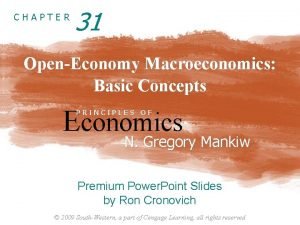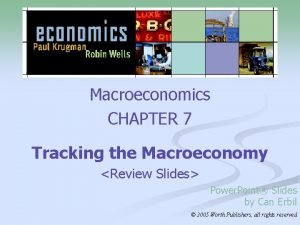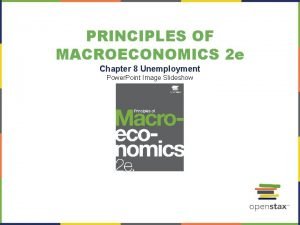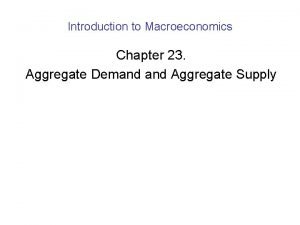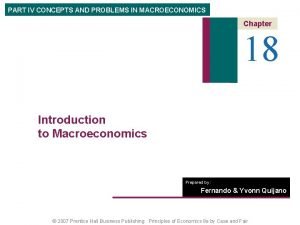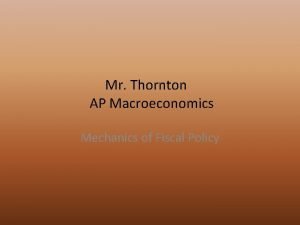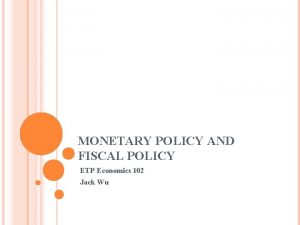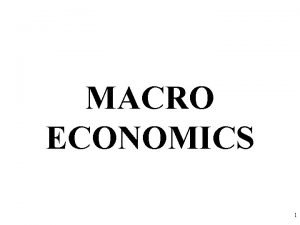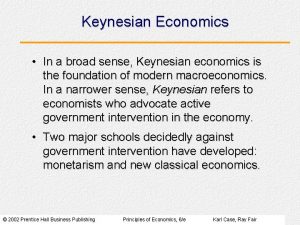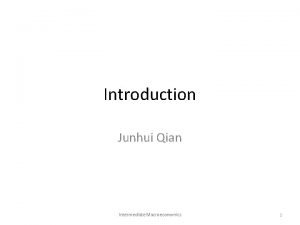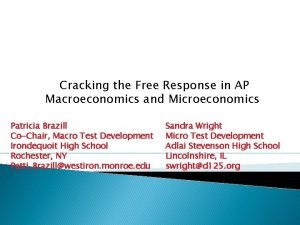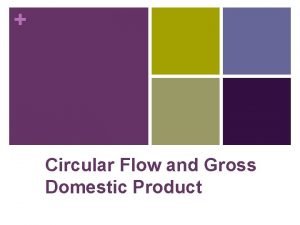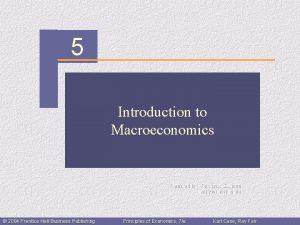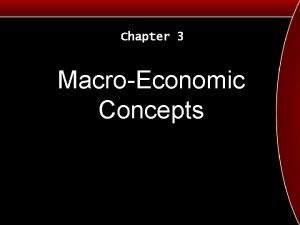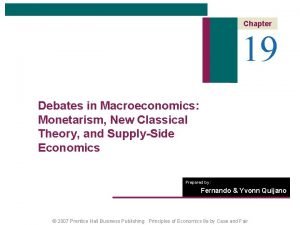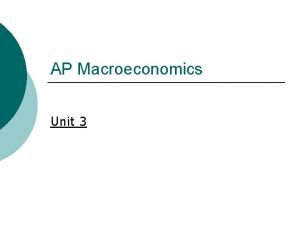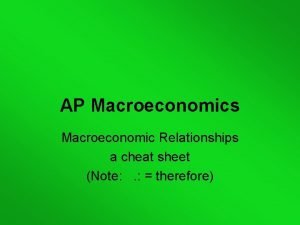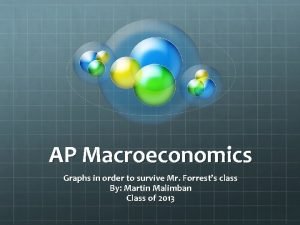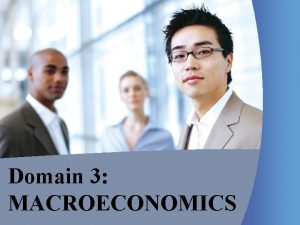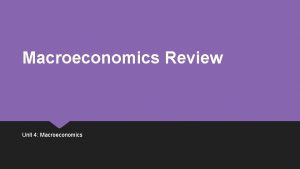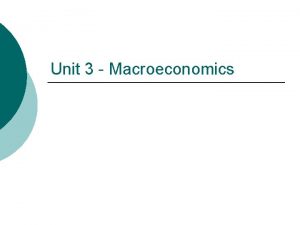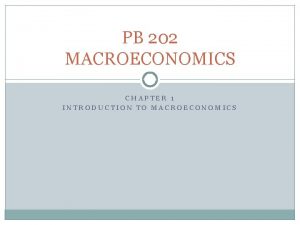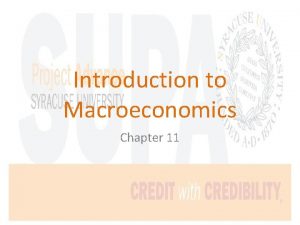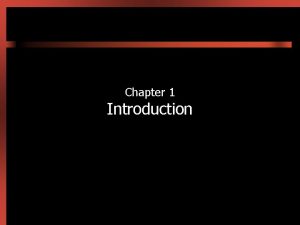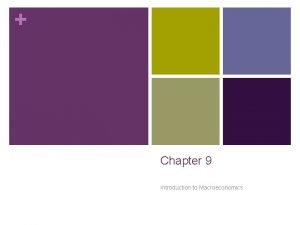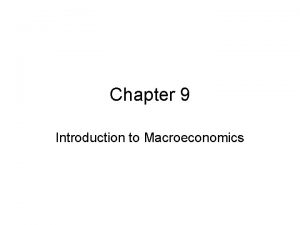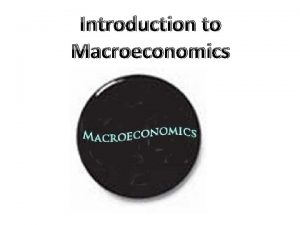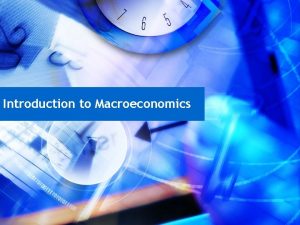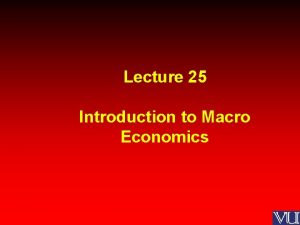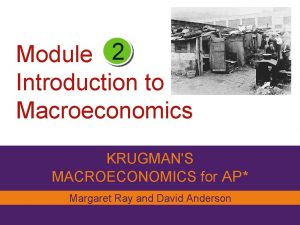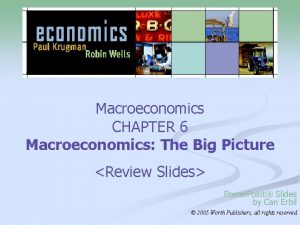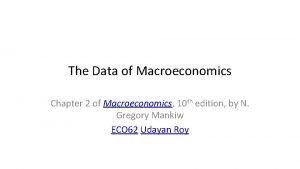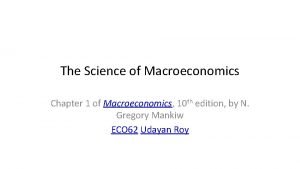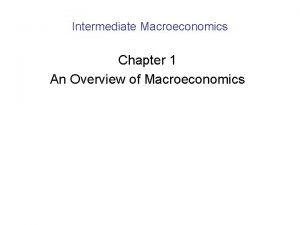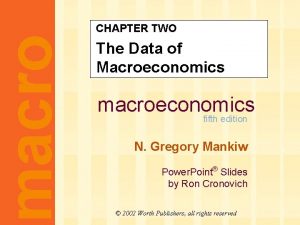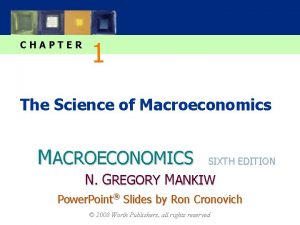Chapter 1 Introduction What is macroeconomics n Macroeconomics
























- Slides: 24

Chapter 1 Introduction

What is macroeconomics n Macroeconomics deals with the overall, or aggregate performance of an economy. ¨ Quantities: n GDP: gross domestic product; n Employment and unemployment; n The balance of payments. ¨ Prices: n GDP deflator, CPI, and others: general price level. n Wage rate: the price of labor. n Rental price and interest rate: the price of capital goods. n Exchange rate: the price of a foreign currency.

What is macroeconomics ¨ Markets: The goods market: consumers, firms, government, and foreigners; n The labor market: consumers and firms; n The asset market: consumers, firms, government and foreigners; n The money market: consumers and government. n ¨ Policy implications emphasized: Is fiscal or monetary policy effective in damping economic cycles or stimulating growth?

What is macroeconomics n Connections with microeconomics. ¨ Aggregation: No longer deal with individual consumer or firm, or the market of individual goods; n A representative consumer and firm. n ¨ Methodology (neoclassical): Based on the behavioral theory of consumer and firms; n Intertemporal choice highlighted; n Dynamic general equilibrium approach. n

Issue and Controversies n Economic growth.

Issue and Controversies n Economic growth. ¨ Growth rate of real GDP in year t: ¨ Mean annual growth rate: 3. 5% during 1870 -2005; ¨ Growth rate of real per capita GDP: 2. 0% during 1870 -2005; ¨ What contributes to long-run growth?

Issue and Controversies n Business cycles.

Issue and Controversies n Business cycles. ¨ Off-trend fluctuation in real GDP; ¨ Booms: real GDP is greater than the trend value; ¨ Recessions: real GDP is lower than the trend value; ¨ Pro-cyclical: a variable that moves in the same direction as real GDP; ¨ Counter-cyclical: a variable that moves in the opposite direction of real GDP; ¨ What causes business cycles? ¨ Are fiscal or monetary policies effective in damping business cycles?

Issue and Controversies n Unemployment.

Issue and Controversies n Unemployment. ¨ Persistent unemployment: averagely 6. 3% during 1890 and 2005; ¨ Unemployment is counter-cyclical; ¨ What causes the cyclical behavior of unemployment? ¨ How should government deal with unemployment? Hands-off policy; n Active fiscal or monetary policy. n

Issue and Controversies n Inflation.

Issue and Controversies n Inflation.

Issue and Controversies n Inflation. ¨ Inflation rate in year t: ¨ Mean annual inflation rate: 8. 8% in 1980 -1981 and 2% in 1992 -2005; ¨ What causes inflation? ¨ Does inflation has real consequences? ¨ What is the optimal inflation rate?

Schools of thought n Neoclassical school: ¨ The big names: Lucas, Prescott, Kydland, Sargent, Barro, Romer; ¨ Theoretical framwork: Theories are based on consumer and firms’ behavior; n Intertemporal choice based on rational expectations; n All markets always clear; n Dynamic general equilibrium model. n

Schools of thought ¨ Major hypotheses: Long-run growth is attributed to technological progress, either exogenous or endogenous; n Business cycles are caused by real shocks; n Nominal shocks generate zilch real effects; n Unemployment reflects labor market frictions, instead of persistent disequilibrium; n Counter-cyclical policies are neutral, if not bad; n Inflation is the outcome of faulty monetary policy. n

Schools of thought n Keynesian school: ¨ Big names: Keynes, Mankiw, Summers, Bernanke; ¨ Theoretical framework: No comments on long-run growth; n Concentrates on business cycles; n Markets are in disequilibrium in the short run and adjust slowly toward equilibrium in the long-run; n Atheoretical in early stages but adopts the DGE framework since 1980 s. n

Schools of thought ¨ Major hypotheses: Business cycles can also be the result of nominal shocks; n Unemployment reflects labor market disequilibrium or an equilibrium under monopsony; n Counter-cyclical policies are effective in damping business cycles; n Tradeoffs between employment and inflation. n

Key concepts n GDP: a measurement of final outputs by an economy. ¨ Nominal and real GDP; ¨ GDP and the growth rate of GDP; ¨ GDP and per capita GDP. n Inflation: a measurement of the evolution of the general price level. ¨ GDP deflator; ¨ CPI, PPI.

Key concepts n Unemployment: a measurement of resource utilization. ¨ Unemployment rate, job-finding rate, jobseparation rate, capital utilization rate; ¨ Nominal and real wage. n Interest rate: a measurement of borrowing cost. ¨ Nominal and real interest rate; ¨ Nominal and real rental price; ¨ Money base and M 2.

Relationships among macroeconomic variables n Growth and unemployment. ¨ Okun’s law: the inverse relationship between the growth rate of real GDP and unemployment rate. u=-0. 5(y-2. 25)

Relationships among macroeconomic variables n Growth and unemployment.

Relationships among macroeconomic variables n Inflation-unemployment tradeoffs. ¨ The Phillips curve: the inverse relationship between unemployment rate and inflation rate (the growth of nominal wage rate) in the short run.

Relationships among macroeconomic variables n Inflation-unemployment tradeoffs.

Relationships among macroeconomic variables n Inflation-unemployment tradeoffs.
 Chapter 31 open economy macroeconomics
Chapter 31 open economy macroeconomics Macroeconomics chapter 7
Macroeconomics chapter 7 Macroeconomics chapter 8
Macroeconomics chapter 8 Vertical supply curve
Vertical supply curve Macroeconomics examples
Macroeconomics examples Components of macroeconomics
Components of macroeconomics Crowding out effect macroeconomics
Crowding out effect macroeconomics Crowding out effect macroeconomics
Crowding out effect macroeconomics Graphing monetary and fiscal policy interactions
Graphing monetary and fiscal policy interactions Significance of managerial economics
Significance of managerial economics Recessionary gap
Recessionary gap Venn diagram
Venn diagram Nominal gdp
Nominal gdp New classical macroeconomics
New classical macroeconomics New classical macroeconomics
New classical macroeconomics Crowding out
Crowding out 2012 macroeconomics frq
2012 macroeconomics frq Macroeconomics circular flow diagram
Macroeconomics circular flow diagram Ap macroeconomics-percentage for a 5
Ap macroeconomics-percentage for a 5 Macroeconomics deals with?
Macroeconomics deals with? New classical macroeconomics
New classical macroeconomics New classical and new keynesian macroeconomics
New classical and new keynesian macroeconomics Ap macroeconomics unit 3
Ap macroeconomics unit 3 Ap macroeconomics cheat sheet
Ap macroeconomics cheat sheet Ap macro graphs
Ap macro graphs
